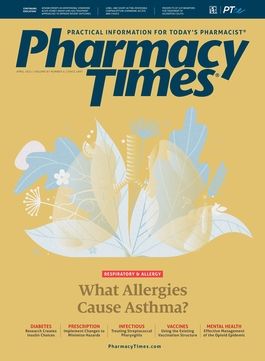Publication
Article
Pharmacy Times
Clinical Pharmacology Update: Gemtesa From Urovant Sciences
Author(s):
The FDA has approved Gemtesa (vibegron; Urovant Sciences) tablets to treat overactive bladder (OAB) with symptoms of urge urinary incontinence (UUI), urgency, and urinary frequency.1
OAB results from the involuntary contraction of the detrusor. Symptoms can include a sudden urge to urinate that is difficult to control, unintentional loss of urine immediately after an urgent need to urinate, urinating 8 or more times in 24 hours, and waking more than twice nightly to urinate.
OAB affects more than 30 million adults in the United States and often significantly affects daily activities.2
Pharmacology and Pharmacokinetics
Gemtesa is a selective beta-3 adrenergic receptor agonist. It exerts its effect by relaxing the detrusor smooth muscle as the bladder is filling, resulting in an increase in bladder capacity.
Gemtesa reaches steady-state concentrations within 7 days of once-daily dosing. The median time to maximal plasma concentration is about 1 to 3 hours, and the elimination half-life is 30.8 hours. Metabolism is minor in the elimination of Gemtesa, with cytochrome P450 (CYP) 3A4 as the predominant enzyme. Gemtesa does not inhibit CYP1A2, CYP2B6, CYP2C8, CYP2C9, CYP2C19, CYP2D6, or CYP3A4, and it does not induce CYP1A2, CYP2B6, or CYP3A4. Gemtesa is a P-gp substrate and does not inhibit P-gp. The pharmacokinetics of Gemtesa are not affected by age, ethnicity, race, or sex. Mild, moderate, or severe renal impairment and moderate hepatic impairment does not affect the pharmacokinetics of Gemtesa.1
Dosing and Administration
The dose of Gemtesa is 75 mg orally once daily, and it may be taken with or without food, either swallowed whole with a glass of water or crushed and mixed in approximately 15 ml of applesauce, followed immediately by a glass of water. Gemtesa is approved for use in adult patients only. It is supplied as a 75-mg tablet.1,2
Clinical Trials
Gemtesa was evaluated in a 12-week, active-controlled, double-blind, placebo-controlled, randomized trial. To be included in the trial, participants had to have OAB with UUI, urgency, and urinary frequency for at least 3 months, with an average of 8 or more micturitions per day; and at least 1 UUI per day or an average of 8 or more micturitions per day and an average of at least 3 urgency episodes per day. UUI was defined as leakage of any amount of urine because the participant felt an urge to or needed to urinate immediately. Both OAB medication-naïve participants and those who had previously used OAB medications were included in the trial. Participants were randomized in a 5:5:4 ratio to receive Gemtesa 75 mg, a placebo, or an active control medication orally once daily for 12 weeks. The coprimary end points were the change from baseline in the average daily number of micturitions and the average daily number of UUI episodes at 12 weeks. Additional end points included the change from baseline in the average daily number of urgency episodes and the average volume voided per micturition. The group using Gemtesa demonstrated statistically significant reductions in the average daily number of micturitions, UUI episodes, and urgency episodes compared with the placebo group. The Gemtesa group also demonstrated a statistically significant increase in the average volume voided than the placebo group.1,2
When evaluating adverse reactions in the clinical trial, it was noted that participants using Gemtesa did not experience the adverse reaction of hypertension at a greater rate than those using the placebo.2
Contraindications, Warnings, and Precautions
The use of Gemtesa is contraindicated in patients with a history of hypersensitivity to any component of the medication.
Some patients using Gemtesa have experienced urinary retention, the risk of which may be increased in patients with bladder outlet obstruction and in those who are using muscarinic antagonist medications for the treatment of OAB.
Patients should be monitored for signs and symptoms of urinary retention. Treatment with Gemtesa should be discontinued in patients who develop urinary retention.
Concomitant administration of Gemtesa and digoxin results in increased digoxin maximal concentrations and systemic exposure. Serum digoxin concentrations should be monitored before, during, and after treatment with Gemtesa, with digoxin dose adjustments as clinically warranted. The effectiveness and safety of treatment of Gemtesa in pediatric patients have not been established. Gemtesa should not be used in patients with end-stage renal disease, with or without hemodialysis, or in patients with severe hepatic impairment. There are no available data on the use of Gemtesa in pregnancy or on the presence of the medication in human milk, the effect on the breastfed infant, or the effect on milk production.
The most common adverse reactions reported during treatment with Gemtesa were diarrhea, headache, nasopharyngitis, nausea, upper respiratory tract infection, and urinary tract infection.1
Monica Holmberg, PharmD, BCPS, is a pharmacist and Pharmacy Times® contributor.
REFERENCE
- Gemtesa. Prescribing information. Urovant Sciences; 2020. Accessed January 11, 2021. https://www.accessdata.fda.gov/drugsatfda_docs/label/2020/213006s000lbl.pdf
- Urovant Sciences announces U.S. FDA approval of Gemtesa (vibegron) 75 mg tablets for the treatment of patients with overactive bladder (OAB). News release. Urovant Sciences. December 23, 2020. Accessed January 11, 2021. https://ir.urovant.com/news-releases/news-release-details/urovant-sciences-announces-us-fda-approval-gemtesar-vibegron-75

Newsletter
Stay informed on drug updates, treatment guidelines, and pharmacy practice trends—subscribe to Pharmacy Times for weekly clinical insights.





